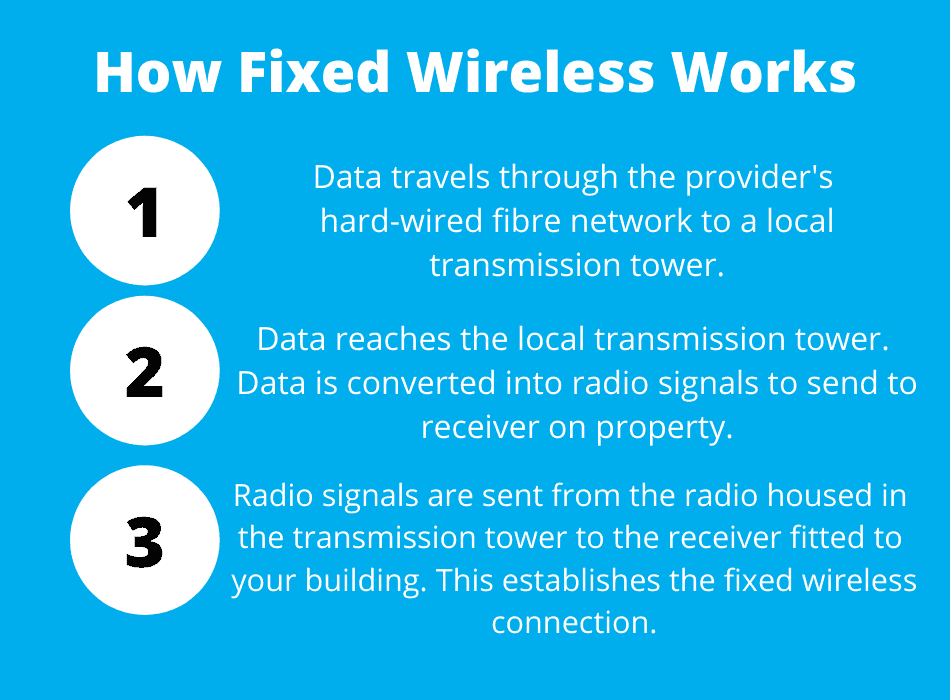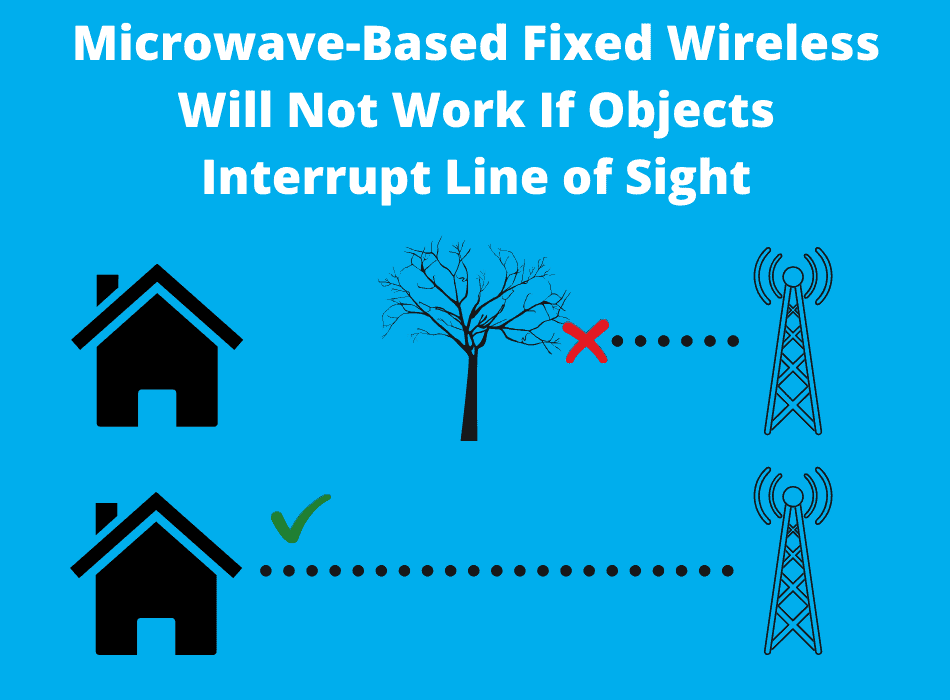Do you live in a rural area where superfast cabled broadband connections are unavailable? A fixed wireless connection could offer your business superfast speeds without the need for any cables. However, is it really the best option for you or are there better options out there?
In this blog post, I will explain the pros and cons of fixed wireless internet. By the end of this post, you’ll hopefully know whether or not fixed wireless internet is a good option for you.
Here are the pros and cons of fixed wireless internet:
- Pros
- Completely wireless
- Low installation costs versus installing physical lines
- Quick installation time
- Superfast speeds
- Cons
- Transmission distance is limited
- Line of sight is required between the transmitter and the receiver
- High monthly cost depending upon the package you choose
Before anything, let’s first briefly cover what fixed wireless broadband is.
What is fixed wireless broadband?
As you’ll know, most internet access is reliant on a physical connection. Whether it’s ADSL, which relies on the copper wire between the roadside cabinet and your property, or FTTP, which relies on the fibre cable connecting your building and the exchange, most internet services need a physical connection.
Fixed wireless is different, which is one of the reasons that it’s such a popular choice in rural areas. A fixed wireless connection uses microwaves, rather than cables or wires. A fixed wireless base station houses radios that communicate wirelessly with receivers fitted to customers’ buildings. As long as there is line of sight between the transmitter and the receiver, a wireless connection can be set up in most cases.

With fixed wireless internet access, you can still enjoy superfast speeds despite the fact that you do not have a physical connection installed. A contended fixed wireless connection will give you speeds similar to FTTC. On an uncontended connection, speeds of up to 2Gbps are possible.
I think that fixed wireless internet access is the best option for businesses and homes in rural areas. You get incredible speeds without the massive expense of installing cable. There are some downsides to fixed wireless, but overall this is the best option.


The pros of fixed wireless internet
Fixed wireless internet is an excellent option for a lot of households and businesses. Here are the key pros of using fixed wireless internet:
- Completely wireless
- Low installation costs versus installing physical lines
- Quick installation time
- Superfast speeds
Next, let’s break down the pros in more detail.
Completely wireless
Fixed wireless, perhaps unsurprisingly, is a completely wireless connection. Other types of superfast broadband connection require cabling to be installed if cabling isn’t already in place. For example, you can’t have a fibre to the premises internet connection if fibre cabling isn’t already laid near your building.
Fixed wireless is a good superfast internet option if installing a physical connection for your building would be either too expensive or impossible. Where fixed wireless internet is concerned, a connection is achieved using microwaves rather than cables. There’s no physical connection needed between your building and your provider’s mast. Instead, a transmitter/receiver will be fitted to your building and pointed towards the provider’s mast. Establishing a connection is as easy as that. The data will be carried into your building using cables and converted into a suitable type of data by your equipment.
If you’re in the middle of nowhere and you know that installing a physical connection would be impossible, fixed wireless broadband is an excellent option.
Low installation costs versus installing physical lines
If you live in a rural area or anywhere that doesn’t have suitable physical lines already installed, consider the expenses of setting up your connection. You will have to pay for the line to be laid, which potentially costs thousands of pounds. On the other hand, installing a fixed wireless connection is inexpensive relative to the cost of installing a physical connection.
I wrote another blog post, How Much Does Fixed Wireless Cost? That covered the costs of fixed wireless in great detail. However, here are the basics that you need to know.
You do typically pay an upfront installation fee for line of sight broadband. As part of this fee, you are paying for the equipment and labour. The installation fee can range from as little as £500 to as much as £1,500 depending on the complexity of your requirements.
That sounds like a lot of money upfront. However, compare this to the costs of installing a physical line if there are none near your property. The costs can be thousands of pounds; even tens of thousands depending upon your particular factors. It really highlights how cheap fixed wireless installation can be.
Quick installation time
With physical connections, you can be waiting weeks if not months for installation. It all depends on how much work needs to be done to install your connection. But for any business, it isn’t ideal to wait weeks or months for the installation of a new broadband solution.
Fixed wireless connections can be installed very quickly, although it does depend upon the provider that you decide upon. In theory, a fixed wireless connection can be set up within a matter days. Usually, installation only requires a dish to be fitted to your property and a cable installed to bring the data into your office.
It’s not always feasible to wait around weeks or months for the installation of a new connection. If there’s a fixed wireless provider operating in your area, they could have you up and running in no time.
Superfast speeds
A fixed wireless broadband connection can provide your business with speeds ranging from 40Mbps to 1,000Mbps/1Gbps. You could have superfast speeds rather than struggling on a poor physical connection simply because there are no fast physical broadband connections available in your area.
Furthermore, a fixed wireless broadband connection can be uncontended. Uncontended means that you’re not sharing the same connection with any other businesses. The biggest benefit of this is that your provider can guarantee your broadband speeds.
The cons of fixed wireless internet
There’s no denying that fixed wireless broadband is a brilliant option for some businesses. However, there are some drawbacks of this type of connectivity.
- Transmission distance is limited
- Line of sight is required between the transmitter and the receiver
- High monthly cost depending upon the package you choose
Let’s have a look at each of these drawbacks in a little more detail.
Transmission distance is limited
Data can only be transmitted over a limited distance using microwaves.
Fixed wireless connections are established using microwave-based technology. Microwaves are used for fixed wireless because their small wavelength can be directed in narrow beams by antennas to a receiver. However, because microwaves travel by line of sight, the two antennas (the one on your property and the one on the mast) need to ‘see’ each other. Because an unobstructed line of sight is needed to transmit data between the two points, the maximum distance data can be sent is around 40 miles (64km).
Transmission distance could be limited by more than 40 miles. It depends primarily upon whether there are any objects interrupting the Fresnel zone. You can read more about what the Fresnel Zone is in my blog post, Does Fixed Wireless Require Line of Sight?
Line of sight is required between the transmitter and the receiver
Line of sight is required between the transmitter and the receiver or else a connection cannot be established. With this in mind, it’s possible that line of sight broadband wouldn’t be a good option for your business.
High monthly cost depending upon the package you choose
Depending upon the package that you choose, fixed wireless internet can have a high monthly cost. For example, monthly cost can rise as high as £500 depending on the speeds that you need as well as variables such as whether you need an uncontended or contended connection.
For a contended connection the equivalent of fibre to the premises, the monthly cost is typically around £65 – £100. For guaranteed speeds of 100Mbps upstream and downstream, you should expect to pay around £240 – £300 per month.
If you compare this to physical internet connections that are available, you’ll notice that fixed wireless usually costs more. However, weigh up the costs of installing a physical connection and fixed wireless probably makes sense.
